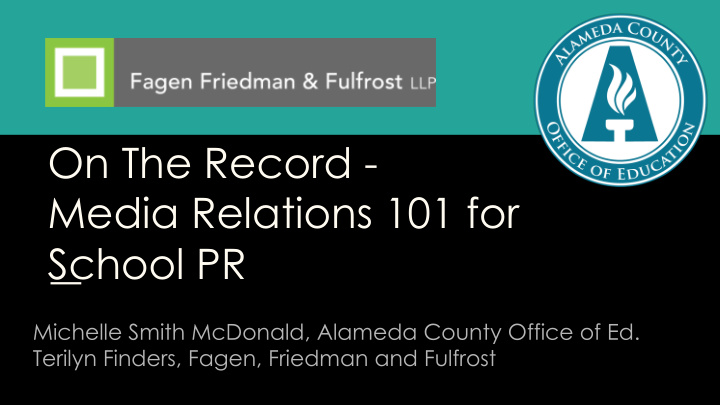



On The Record - Media Relations 101 for School PR Michelle Smith McDonald, Alameda County Office of Ed. Terilyn Finders, Fagen, Friedman and Fulfrost
Your District’s Name in Print Dealing with print reporters
The print media landscape is changing rapidly Local newspapers are enduring significant cuts, meaning fewer reporters, less coverage. Reporters are often times less experienced, particularly in covering specific beats; they know less about your districts than they used to. How you deal with them is changing too.
Building Relationships ● Find your writer ● Find their editor ● Be a resource on the good days ● Be responsive on the bad days ● Be careful with “off-the- record” ● Keep those business cards
What’s A Story? To Your District: Sanctioned events, recognitions activities that highlight student/staff achievements To The Media The Issue The Incident The Crisis Conflict is king
We’ve Got Great News to Share… The Story Pitch Does Keep It Short and Simple (KISS) still apply? Not necessarily... Provide the easy path to a story, including quotes and potentially photos...
Don’t Worry...They’ll Call You News isn’t always great. 1. Put protocols in place to know when media is reaching out (notify DO of all media contacts; PIO handles all media); make sure to let others know when you’ve been contacted (Board, Superintendent, site leaders) 2. Be responsive and accessible. There is no good reason to avoid a media call. It won’t help your district avoid coverage. 3. Don’t be afraid to ask: What’s the story?; What do you already know? What is your deadline?
Get the Word Out... 1. The Press Release “I want your attention” 2. *The Press Statement Issue something brief and to the point 3. *The Holding Statement To issue when media calls *Make sure you are not issuing any info you haven’t already sent out to your community
Staying On Message On-Camera
Lights, Camera, Action...
So You Wanna Be on TV... 1. The Cold Call Don’t avoid; get your info together before agreeing to interview 2. The Trucks Access to campus with permission only; otherwise it’s the curb Student media release/rights When One Comes, They All Tend to Show Up Stick close while the trucks are there 3. Remember the Sound Byte 4. B-Roll You are not obligated to give them access to your schools It can be disruptive and disconcerting to have cameras on campus during the school day
Be Ready for Your Closeup! Don’t Do ● Don’t repeat words you ● Frontload your key 2-3 don’t want to hear/read messages and stick to ‘em ● Don’t speculate/offer ● Acknowledge the question, opinion pivot to message ● Don’t answer something if ● Anticipate the tough you don’t know the questions; have responses answer ready ● Do not answer for others ● Focus on the message, not ● Do not feel you need to the camera fill silences ● Remember you are talking to your community ● Maintain privacy
The Message no Matter the Medium... Choose Your Words 1. Connect/Confront What you need to Empathy say/What they need to hear from you Humility 2. Clarify Confidence 3. Accountability; tell the Accessibility truth, say it first
The Burning Questions... 1. Is there such a thing as too much information? 2. Who “should be” speaking for your district? 3. Is their deadline your deadline? 4. When do you need to ask for help?
The Day After... 1. Make every effort to correct erroneous information 2. Send clips and video links to leadership and Board (and possibly staff) so they have an opportunity to see how District is portrayed 3. Get ready for more.
Questions?
Recommend
More recommend